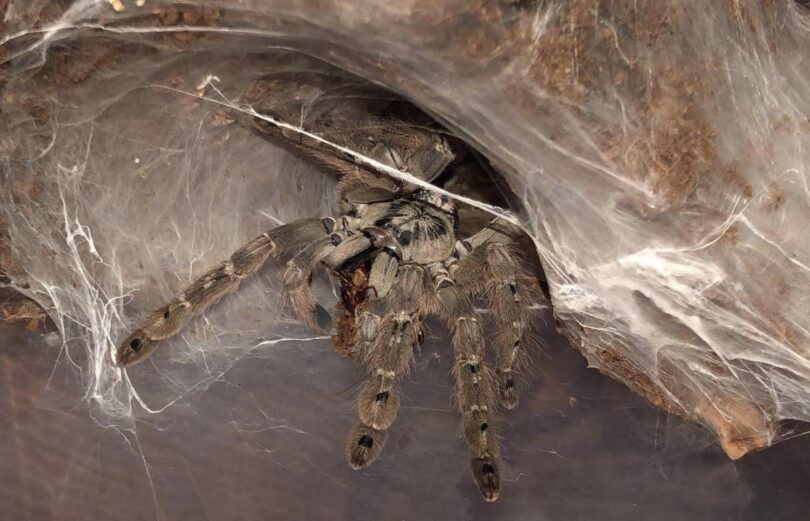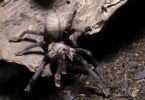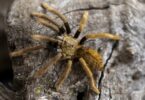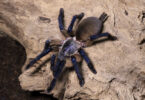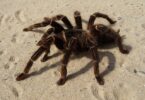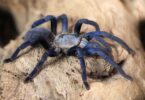The Togo Starburst Baboon, also known as Heteroscodra maculata, is a striking tarantula with its unique patterns and colors. The species was described in 1899 by Pocock.
Our blog post will guide you through caring for these captivating creatures, from setting up the perfect habitat to understanding their behavior. Get ready to discover everything about your soon-to-be favorite arachnid!
Description of Heteroscodra maculata
Dive into the world of the Heteroscodra maculata, a striking arboreal species that captivates with its unique patterns and agile movements. Often hailed as a jewel among tarantula collectors, this Togo Starburst Tarantula sports an impressive size and can boast quite the life span if cared for properly—let’s unveil its habitat too, as understanding their natural setting is key to mimicking it in captivity!
Appearance (size and lifespan)
Heteroscodra maculata, or the Togo Starburst Tarantula, is a sight to behold! Full-grown, these spiders stretch out to around 11 to 13 centimeters.
In just about three years, they can shoot up from tiny spiderlings to their impressive adult size. And if you’re lucky and take great care of them, they might live up to 15 years.
Their bodies are covered with an eye-catching black pattern against a white-gray background – it’s like looking at a burst of stars against the night sky. This isn’t your everyday tarantula with its striking looks and swift growth.
Easy to see why you’d want one skittering in its terrarium on your shelf!
Habitat
The Togo Starburst Tarantula loves the high life—literally! In the wild, they hang out in trees and other tall spots in humid forests of Togo and Ghana. Picture them chilling above ground, away from the forest floor, where it’s damp and full of life.
This love for height makes sense because they are an arboreal species; that means tree-living is their thing. They’ve got this cool ability to adapt too—if there’s nowhere to hide up high, they’ll dig into the substrate below to make a cozy spot for themselves.
The key is staying hidden and safe from danger while keeping close to all the action in their treetop homes.
These spiders have it figured out—staying moist but not too wet, warm but never hot. Their natural homes offer just the right mix of humidity and temperature so important for their well-being.
Think about that when you’re setting up your own tarantula’s home away from home!
Behavior and Venom Potency
Heteroscodra maculata, Togo Starburst Baboon Tarantula, is fast and feisty. With quick moves, they can dart out of sight before you know what happened. Don’t expect them to be friendly; they value their space and will defend themselves if bothered.
A bite from one of these guys packs a punch! Their venom hits hard—it’s not just strong but sneaky too, targeting pain pathways that your body might not be ready for.
This spider isn’t like your average pet. Sure, it has beautiful markings—starbursts indeed—but its temperament is serious business. Handle with care or better yet, don’t handle at all to stay safe.
Its venom potency makes this tarantula best admired from a distance within the safety of an enclosure where it can climb freely without feeling threatened or needing to strike.
Enclosure for Heteroscodra maculata
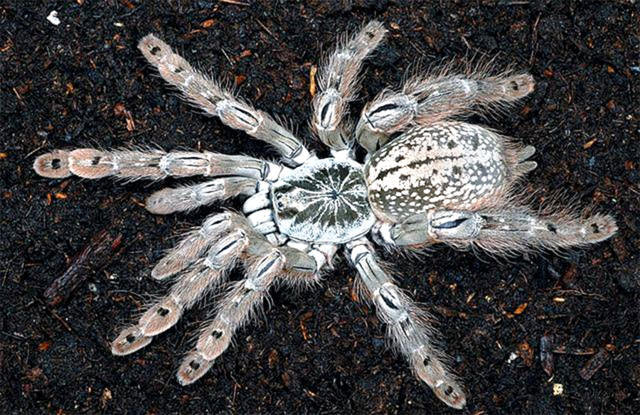
DiamondPlayboy, CC BY-SA 4.0, via Wikimedia Commons
Creating the perfect home for your Heteroscodra maculata is like setting the stage for an arachnid superstar – it’s all about arboreal setup and giving them a space to showcase their impressive climbing skills.
Just remember, these clever spiders might just surprise you with their knack for burrowing when they want a little privacy..
Arboreal terrarium
For your Togo Starburst Tarantula, think tall home, not wide. They love to climb and need a space that goes up more than out. Get an enclosure with lots of vertical room for them to feel at home.
They might even start digging if there’s no good hideaway spot above ground.
Remember, these spiders change as they get older. Young ones might hang out on the ground sometimes, but grown-ups stick to the trees—or in this case, branches and plants you put in their cage.
Make sure it’s like their natural habitat; filled with things to climb on like cork bark so they can do their thing just like in the wild!
Humidity and temperature
Getting the humidity and temperature right is key for a happy Heteroscodra maculata. These tarantulas need warmth, so keep their space between 80° and 84°F. They enjoy high moisture too – aim for humidity levels from 70% to 80%.
To make sure your spider stays comfy, keep their substrate damp but not soaked. You’ll also want to give them a small water dish for sips when they’re thirsty. Spray the enclosure with water every day; this helps maintain that crucial high humidity they love.
Keeping these conditions just right supports healthy molting and overall well-being of your Togo Starburst Tarantula.
Breeding Heteroscodra maculata
Breeding Heteroscodra maculata isn’t hard. Owners often find success with their spiders having babies.
– Make sure you have a healthy male and female. They should be mature but not too old.
– Put the male in the female’s enclosure carefully. Watch them closely to keep the male safe from harm.
– Females can lay eggs a second time without mating again. This happens sometimes after the first egg sac is made.
– After mating, remove the male right away. Female tarantulas can hurt or eat males if left together for too long.
– The female will make an egg sac with 250 eggs, which she guards fiercely. Give her lots of peace during this time.
– Baby spiders, called spiderlings, come out after several weeks. Be ready with small containers to house each one (cannibalism) safely.
Keep these tips in mind and your tarantulas might just surprise you with new life!
Conclusion
So, you’ve learned a bit about the cool Togo Starburst Tarantula. These spiders are fast and can be feisty, but they sure are interesting! Remember, if you want one as a pet, they need a special home to climb and hide.
And hey, folks who know what they’re doing can even get them to have baby spiders more than once! All in all, the Heteroscodra maculata is an awesome spider with quite the personality.
FAQs
1. What’s the temperament of a Heteroscodra maculata?
The Heteroscodra maculata, also known as the Togo Starburst Tarantula, is quite feisty – it’s known to be fast and can act defensive if it feels threatened.
2. Is the venom from a Heteroscodra maculata dangerous?
The venom of this tarantula isn’t deadly to humans, but hey – if you get bitten, it might hurt pretty bad and cause some discomfort.
3. Will a bite from a Heteroscodra maculata tarantula need medical attention?
Most bites just hurt for a bit; however, treat with care! If you’re feeling really bad after getting bitten by one of these guys or any weird symptoms show up… better see a doctor.
4. Should I worry about my Heteroscodra maculata biting me often?
Not usually – they’d likely rather run away than attack. But remember: they’re quick movers with an attitude so when handling them or cleaning their home… proceed with caution!
5. Is Togo Starburst arboreal?
Heteroscodra maculata is a tree-dwelling tarantula; however, it often constructs its nests just above the ground, and in captivity conditions, it is known to create its nest within the substrate.

